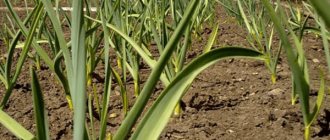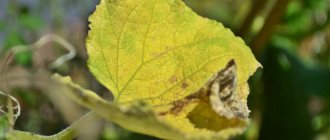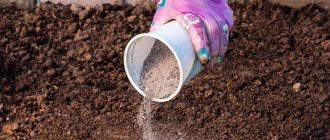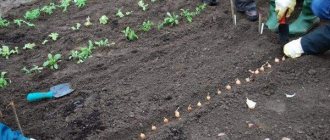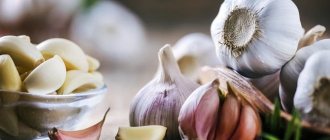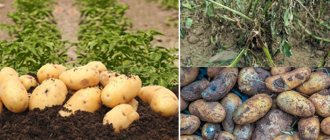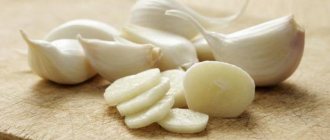Main reasons, signs and what to do
The tips of garlic tops first turn yellow, then the yellowness spreads further, which slows down the growth and development of the plant. Let's consider the main reasons for this process.
Nitrogen deficiency
At the beginning of spring, the soil is still cold, which affects the formation of minerals. Nitrogen deficiency manifests itself at an early stage of plant development. Symptoms that indicate nitrogen deficiency in garlic:
- yellowish and pale green color of leaves;
- small and flaccid shoots of the plant.
The lack of nitrogen is compensated by fertilizers that contain nitrate or ammonium nitrogen:
- potassium nitrate;
- sodium nitrate;
- ammonium nitrate;
- ammonium sulfate;
- urea.
If the acidity of the soil is increased, nitrate nitrogen (sodium, potassium, ammonium nitrate) is more effective; if the acidity is neutral or alkaline, ammonia nitrogen (urea, ammonium sulfate) is used.
Low temperature in spring
Capricious spring weather is one of the possible reasons for yellowing of garlic. Frail young leaves are damaged by sudden spring frosts.
To protect against spring frosts, the seedlings are covered with film. Damaged sprouts are treated with stimulating drugs (Epina, Zircon).
Potassium deficiency
Potassium supports water metabolism, promotes plant resistance to disease and improves immunity. If there is a deficiency of this element in garlic, in addition to yellowing, the following changes occur:
- the leaf blade acquires a bluish tint;
- the edges of the leaves become brown (marginal burn occurs);
- plant growth will slow down.
To improve health, garlic is fertilized with potassium sulfate, potassium magnesium, and wood ash.
Insufficient watering
Garlic likes moderate watering. Lack of moisture causes dryness in the upper and lower leaves. Water the garlic as needed:
- in April-May no more than three times a month;
- a month before harvest, watering is stopped.
To determine whether there is enough moisture in the soil, the soil around the garlic is loosened. In addition, this procedure provides air access to the roots.
Too much moisture is worse for garlic than not enough! If the spring is dry, water the garlic more often (once a week); if it is rainy, do not water it.
Unsuitable soil
Increased acidity of the soil is another reason for yellowing of garlic leaves. Suitable soil for this crop is neutral with a slightly acidic reaction.
Garlic loves:
- level, illuminated beds (without recesses in which water stagnates);
- loamy (for spring) and sandy loam (for winter varieties of garlic) soil;
- soil well fertilized with organic fertilizers.
To deoxidize the soil, fertilizers containing lime are used.
Garlic diseases
Leaves may turn yellow due to disease. The most common diseases:
- Downy mildew (downy mildew) . Light green blurry spots appear on the leaves, then a gray coating develops, which leads to yellowing of the garlic. It is transmitted from infected vegetable crops through the air or through the soil.
- Fusarium . Occurs due to excess moisture and lack of nutrients. The tips of the leaves turn yellow and die.
- Black mold . Appears on the upper layers of scales, softens them, and penetrates further. The cause of the disease is sudden temperature changes.
- White rot . White mold affects the bulbs, after which the garlic rots and the leaves turn yellow. Drought and nitrogen deficiency cause this disease.
- Green and blue mold (penicillosis) . Rot affects garlic cloves due to improper harvesting. The pathogen persists in the soil and becomes a cause of infection, especially in conditions of high humidity.
- Rust . The leaves have yellowish-rusty spots that are caused by microscopic fungi that cause the disease. Incorrect planting (in the same place every year or in the place where the onion was planted), residues of vegetation after harvesting provoke rust infection.
- Mosaic . This disease is caused by viruses. The leaves become yellow-orange, mint, and corrugated in shape.
In order to prevent infection, garlic is disinfected with a weak solution of potassium permanganate or other means (Fitosporin, Maxim fungicide) before planting.
Errors during landing
Winter garlic is planted in winter, spring garlic in spring. Failure to comply with crop rotation conditions can cause yellowing in the spring of both winter and spring garlic. Main mistakes when landing:
- the timing does not correspond to the temperature regime: in warm weather, garlic germinates before the first cold snap and does not have time to adapt to low temperatures;
- planting to a depth of less or more than 5-7 cm;
- planting garlic in the place where onions grew and in the same place for several years in a row.
Read the article about spring planting spring garlic.
The following video explains the reasons for yellowing of garlic leaves:
The optimal planting time is three to four weeks before frost. When planted to a depth of 5-6 cm, garlic can withstand temperatures down to -25°C.
Pests
They weaken the plant, cause rotting of the bulbs, yellowing of feathers and parasitic pests:
- Nematodes . Small worms parasitize the bulb.
- Onion fly . It lays eggs in garlic, from which voracious larvae hatch.
- Garlic mite . Lives in the ground and feeds on root crops, spreading viral diseases. A characteristic symptom of garlic damage is yellow spots on the cloves.
- Tobacco thrips . This winged brown-yellow insect feeds on garlic juice. White spots on the feathers are thrips marks.
To repel pests, some gardeners plant calendula or marigolds between the beds.
Garlic turns yellow after frost
In the climate of the middle zone this is not uncommon. It happens that the garlic overwintered well, the first leaves after emerging above the soil surface were green, but after some time they turned yellow. Then remember what the weather was like this week. Was there any frost or significant cold after germination? If so, then the plants could be damaged by them.
If the garlic has turned yellow due to cold weather , it can be treated with stimulants: Epin or Zircon.
Methods of healing
Nitrogen deficiency is compensated by:
- A solution of urea or ammonium nitrate (1 tbsp per 10 liters of water). This mixture is poured under the roots of the garlic or sprayed on the tops.
- From organic fertilizers - slurry. Water the plant (1 part of liquid per 8 liters of water) at the beginning of the growing season and two weeks after the first watering.
For potassium deficiency use:
- Calimagnesia (10 g per 10 liters of water). Carry out both foliar (on tops) and sub-root watering once a week until the symptoms disappear.
- Superphosphate (25 g per 10 liters of water). The tops are sprayed with a spray bottle or the garlic is watered at the root.
- Ash (2 glasses per 10 liters of water). A two-day infusion is poured over the garlic at the root.
If you are not sure about the lack of mineral substances that cause garlic to turn yellow, use complex fertilizers, for example, nitroammophoska.
High acidity of the soil is neutralized with limestone mixed with the soil. If the acidity is high, then 55-70 kg of lime is required, if the acidity is medium - 35-45 kg, with low acidity 30-25 kg is enough.
When garlic is severely damaged by pests, insecticides are used, but only if other control methods are not effective. Harmful substances contained in chemicals accumulate in plants. To begin with, you can try less harmful and folk remedies:
- Tansy decoction (3 kg of flowers per 10 liters of water). The boiled and cooled broth is sprayed onto the tops.
- Nettle decoction (1 kg of leaves per bucket of water). After the broth has fermented for 4-5 days, it is filtered, diluted (1 part to 50 parts water) and sprayed on the garlic tops.
- A solution of ammonia (20-25 g per 10 liters of water).
- Salt water (200 g per bucket of water). Sprinkle garlic leaves with a salty solution to prevent onion flies. The next day, water the garlic with clean water.
All these products repel pests. Decoctions from other plants are also used: chamomile, potato tops, yarrow, shag. The following chemicals are used:
- insecticide "Aktellik" (2 ml per 2 liters of water) against ticks;
- insecticide “Dachnik” (1 ml per 1 liter of water) against onion fly;
- the drug “Carbation” (200 ml per square meter), “Vidat” (2 g per well) against nematodes.
The soil is treated with Carbation in August, and with Vidat during planting.
Garlic diseases are treated using the following remedies:
- Fungicide "Hom", copper sulfate for rust. The stems are irrigated once every 14 days; a month before harvesting, irrigation is stopped.
- The drugs “Fentiuram” (3 kg per bucket of water), “Polycarbocin” (40 g per bucket of water), “Arcerida” (30 g per bucket of water) help against peronosporosis.
- The preparations “Agat-25K”, “Previkur” (1.5 ml per liter of water), “Fundazol” (1 g per liter of water) are used against fusarium and rot.
- The insecticide "Karbofos" is used against mosaics (the affected tops are sprayed).
The gardener shares his experience in dealing with garlic diseases and yellowing of leaves in his video below:
It is necessary to observe safety precautions when working with chemicals and use insecticides according to the instructions.
Boarding too early
If you plant garlic ahead of schedule, then before frost it can not only take root, but also germinate. In winter, such garlic will not die, but will weaken significantly.
What to do? You need to care for yellowed garlic in the same way as healthy ones. At the same time, it is important not to forget to water and feed the plantings on time so that the plants regain their strength as quickly as possible.
- Planting garlic before winter - all the subtleties of planting with cloves
We tell you how to properly plant garlic in the fall.
Preventive actions
To ensure that the garlic in the beds does not turn yellow and produces a good harvest, preventive measures are carried out:
- In the middle regions of Russia, they try to plant winter garlic before the end of October, in the southern regions - until the end of November.
- Before planting, the soil is dug deeply and fertilized with compost or fertilizers (superphosphate, potassium sulfate).
- Planting garlic heads are treated with weak potassium permanganate or copper sulfate. You can treat it with the drug “Maxim” (1 ampoule per liter of water), it protects against bacteria.
- Carefully inspect the garlic before planting, selecting only large and undamaged ones.
- To adapt the plant to temperature fluctuations, biostimulants, for example, Epin, are used.
- The same place for garlic beds is used for no more than two years.
- They plant garlic where pumpkin, zucchini, and cabbage used to grow.
To avoid infection of garlic by pests, bacteria and fungal diseases, the following procedures are carried out:
- If the weather is hot and humid for several days, the soil is loosened to reduce moisture. This is a prevention against certain types of rot, fusarium, powdery mildew, which prefer a warm, humid habitat.
- The plants are treated with a solution of carbon-ammonium nitrogen salt against onion fly, yellow spot, and powdery mildew.
- Disinfect areas where garlic is stored with bleach or formaldehyde to prevent pest infestation.
- Dolomite flour is added to deoxidize the soil. Nematodes in neutral soil move poorly and freeze.
- Plant garlic away from onion beds and bulbous flowers.
- After harvesting and digging the beds, the plant residues are burned.
- The garlic is carefully inspected for damage and signs of disease, and dried for about three weeks before storing.
Compliance with preventive care measures will have a positive effect on productivity and save the plant from diseases and other troubles. If it was not possible to avoid yellowing, the recommendations given will help identify the cause and choose the right method of recovery.
0
0
Copy link
Wrong landing location
Garlic does not grow well in soil that is too heavy or acidic. It is best to plant it in light soil with a high content of organic matter and a neutral pH.
What to do? If it is not possible to find a suitable place for garlic on the site, the soil must be prepared in advance. To reduce its acidity, you should add ash or dolomite flour to it. Heavy soil should be “filled” with organic fertilizers. If necessary, they can be replaced with sand or peat.
Answers to frequently asked questions
What to water if the garlic turns yellow?
There may be several options. This includes a solution of chicken manure, ammonia, and nitrophoska. It is important to find out the cause, and then carry out treatment.
How to feed garlic?
Ash is an excellent remedy for preventing yellowing. But it also helps at the first signs of illness. Ash can be scattered over the garden bed if there is rain in the forecast, or you can prepare a solution from it and pour it over the garlic.
How to prevent yellowing of garlic using folk remedies?
As is usually the case, preventing a disease is much easier than treating it later.
Timely fertilizing will prevent the garlic from turning yellow and keep the crop healthy.
As a preventive measure, you can water the garlic with mullein infusion immediately after removing the cover.
As an alternative, you can choose an infusion of bird droppings. It is better to buy fertilizer in granules and prepare it according to this recipe: 1 kg of product, 20 liters of water.
Mix everything, cover and leave for fermentation. After a week, dilute the resulting concentrate in a ratio of 1 to 10. With this working solution, you can feed the vegetable from yellowing.
A week or two after you water the beds with this product, you can apply yeast fertilizer. Bacteria will begin to process organic matter, releasing beneficial microelements and increasing the efficiency of feeding.
Reviews from experienced gardeners
Veronica, 53 years old, Stary Oskol
Yellowing of garlic leaves is not always associated with some unpleasant issues. It’s just that on an adult plant, the yellowness at the bottom of the feathers indicates the beginning of the formation of the bulb. There is an outflow of nutrients from the stems to the roots. Additional fertilizing with potassium-containing fertilizers or ash is required.
Mikhail, 47 years old, Shchelkovo
In order to always have a garlic harvest, you need to make raised beds. Garlic, planted in the fall, becomes one of the first plants to appear in the garden. And high beds warm up faster in the spring sun, it is convenient to carry out all work on them, and they are easy to mulch.
Natalia
Author
Ask a Question
Many gardeners are engaged in growing garlic, and most produce good harvests of large heads, which are stored well in winter. In fact, caring for garlic beds does not pose any particular difficulties, but sometimes lack of experience and bad weather let you down. But everything can be overcome - if desired. Health to you and your loved ones!
